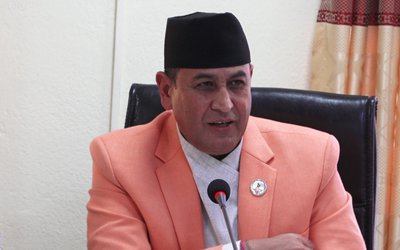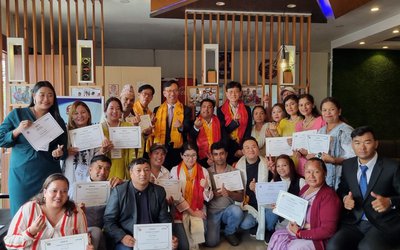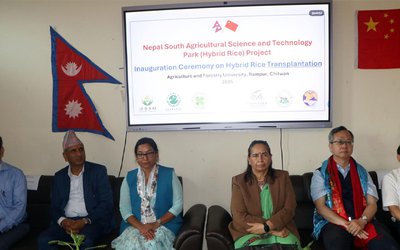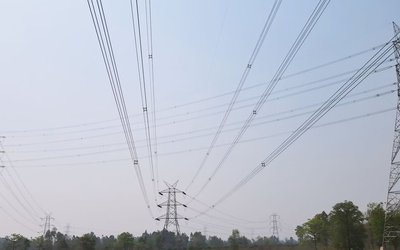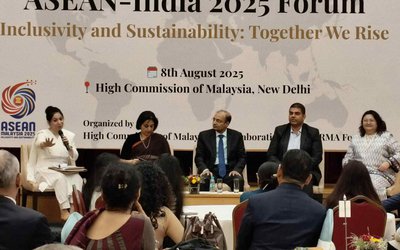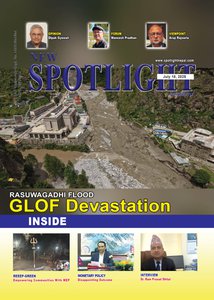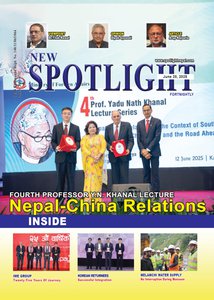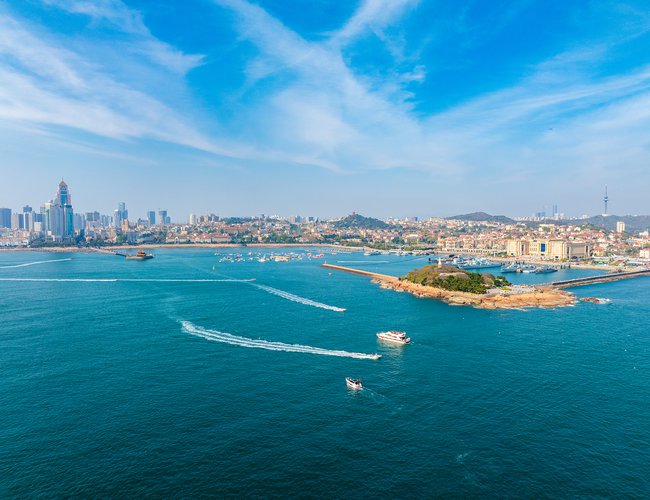
East Asia on the Brink: Climate Change and Development Fuel an Ecological Collapse
Recurrent disasters and climate-induced risks have accelerated ecological declines across East Asia, posing serious threats to biodiversity and sustainable land resource management. The region faces a web of interlinked environmental stressors that are amplifying its vulnerabilities. In China, desertification degrades 1.5 million hectares of land each year in Inner Mongolia, and extreme weather events like the 2023 Yangtze River floods have resulted in habitat loss and water contamination, endangering species such as the Yangtze finless porpoise (World Bank, 2023). These trends point to a pressing need for climate-resilient land management. South Korea’s west coast tells a similar story of the ecological cost of unchecked development: there, rapidly expanding urban areas have encroached upon key ecosystems such as the Ramsar-listed Saemangeum tidal flats (UNEP, 2023). Mongolia’s semi-arid landscapes are growing increasingly vulnerable, with over 70% of rangelands degraded due to persistent drought, overgrazing, and scarce water (UNDP, 2023). Taiwan and Japan are confronting record heat waves and shifting rainfall patterns which place wetlands and forest ecosystems under acute stress and signal the urgency of localized adaptation (National Taiwan University, 2024; UNESCAP, 2023). In North Korea, over 80% of wetlands have vanished under the pressure of agricultural expansion and land reclamation, a loss which has intensified biodiversity collapse (UNEP, 2023).
Pollution continues to fragment ecosystems across the region—most starkly in Beijing, where PM2.5 concentrations far exceed global safety limits, straining public health and environmental integrity (World Bank, 2023). The convergence of desertification, wetland loss, habitat fragmentation, rising heat, and pollution underscores the systemic nature of these challenges. To reverse these trends, East Asia urgently needs cross-sectoral, climate-smart strategies that integrate land, water, and biodiversity management. The rise in environmental pressures demands coordinated regional action which prioritizes sustainable resource use, the restoration of degraded ecosystems, and the building of resilience in the face of an increasingly volatile climate (UNFCCC, 2024). Without bold, collaborative responses, the region’s ecological foundations will continue to erode.
East Asia’s Ecological Crisis: Land, Climate, and Biodiversity All under Siege
Desertification and land degradation: Driven by the compounding pressures of climate change, overgrazing, and unsustainable land use, desertification and land degradation are intensifying across East Asia. The Gobi Desert continues to encroach on inhabited areas of China by an estimated 3,600 square kilometers annually; indeed, desert now covers nearly 27% of the country’s territory. Despite ambitious interventions like the Three-North Shelterbelt Program, which has greened over 22 million hectares (UNCCD, 2023), the ecological and agricultural toll of desertification remains severe; it diminishes soil fertility, disrupts ecosystems, and magnifies climate vulnerability. In Mongolia, overgrazing and prolonged drought have caused nearly 70% of pastureland to show signs of degradation, a state which imperils both biodiversity and the centuries-old pastoralist way of life (World Bank, 2022). The result is deepening rural poverty and increased pressure on fragile landscapes. South Korea faces similar threats, particularly in its mountainous zones, where deforestation and unchecked urbanization are accelerating soil erosion, thereby threatening agricultural sustainability and ecological stability (UNEP, 2023). Meanwhile, reports from North Korea suggest it is experiencing extensive soil degradation and declining crop yields, both symptoms of intensive land misuse and inadequate land governance (FAO, 2023). These trends reveal a regional challenge demanding urgent attention: degraded lands are not only losing their productive capacity but also heightening communities’ exposure to climate extremes and food insecurity. Reversing these patterns requires bold, coordinated action anchored in sustainable land management, ecosystem restoration, and resilient agricultural practices if the region’s environmental and socio-economic future is to be safeguarded.
Flooding and extreme weather events: Flooding and extreme weather events are emerging as potent disruptors of biodiversity and sustainable land use in East Asia, especially as their frequency and intensity has risen in recent years. Typhoon Doksuri unleashed devastating floods across Hebei Province, China, in August 2023, displacing thousands and inflicting severe damage on farmlands and ecosystems. The resulting disruption to livelihoods and agricultural systems underscores the fragility of both human and natural resilience under climate stress. South Korea’s 2023 deluge—the heaviest rainfall in over a century—flooded more than 34,000 hectares of farmland and damaged cultural landmarks. The damage highlighted how climate extremes not only erode ecological integrity but also threaten historical heritage and rural economies (Yonhap News Agency, 2023). Japan’s record-breaking 2024 heat waves, with temperatures peaking at 41°C, resulted in over 123 deaths and more than 37,000 hospitalizations (Japan Meteorological Agency, 2024). These extreme temperatures strained public health infrastructures and pushed ecosystems beyond their coping thresholds, disrupting the behavior of species and the stability of habitats. In 2023, Taiwan experienced its worst drought in over five decades; it depleted water supplies for agriculture, communities, and critical wetland ecosystems (Greenpeace, 2023). The severity and breadth of these impacts call for a paradigm shift towards climate-resilient planning, disaster risk governance, and nature-based solutions to buffer ecosystems and societies against the mounting toll of extreme weather.
Loss of wetland ecosystems: Wetland ecosystems across East Asia are under mounting pressure from climate change, land reclamation, and unsustainable development, leading to significant biodiversity decline and weakening the region’s ecological resilience. In China, the Songnen and the Sanjiang plains, both once expansive marshlands, have been severely degraded by decades of rice cultivation and, since the 1980s, state-led land reclamation policies and now have experienced the loss of vital habitats and diminishing ecosystem services (MDPI, 2020). Their transformation has eroded biodiversity and weakened the ability of ecosystems to buffer communities against environmental shocks. In Mongolia, prolonged droughts and advancing desertification have caused rivers and wetlands to dry up, with nearly a third of freshwater systems affected between 1996 and 2009 (UNEP, 2010). The loss of aquatic habitats has jeopardized native species and heightened water insecurity for both herders and wildlife. South Korea’s rapid urban and industrial expansion continues to encroach on both coastal and inland wetlands, placing migratory bird populations at risk and reducing water quality in critical habitats (UNEP, 2010). This degradation threatens the delicate ecological networks vital for regional biodiversity and compromises people’s access to clean water. Taiwan’s wetlands, too, have been reshaped by conversion to agricultural land and the construction of infrastructure, leading to a sharp decline in ecosystem services such as flood control, water purification, and biodiversity regulation (UNEP, 2010). Together these trends signal a pressing need for coordinated wetland conservation policies and nature-based solutions to reverse habitat loss, restore ecological function, and enhance climate resilience across East Asia.
Drought and water scarcity: Driven by climate change and unsustainable water governance, drought and water scarcity are intensifying across East Asia, with profound implications for food security, livelihoods, and ecological stability. In China, the 2023 drought, which is among that nation’s worst in decades, impacted over 200 million people and triggered widespread crop failures and severe water shortages, particularly in the Yangtze River Basin (UN, 2023). This crisis underscores the fragility of water systems under climate stress and the urgent need for resilience in agricultural and urban planning. In 2023, Mongolia experienced one of its most severe dzud events, where the dual impacts of prolonged drought and brutal winter conditions led to catastrophic livestock losses, affecting over 220,000 herding households and exacerbating rural poverty (UNDP, 2023). The loss of herds, a cornerstone of livelihoods, exposed the rural economy to cascading vulnerabilities. The significant drops in reservoir levels that South Korea experienced in 2023 disrupted irrigation systems and limited municipal water supply, consequences highlighting that both rural agriculture and urban infrastructure were under strain (UN, 2023). Taiwan’s worst drought in over half a century similarly strained water reserves, affecting not only human consumption and agricultural output but also critically degrading wetland ecosystems essential for biodiversity and natural water regulation (UN, 2023). These converging crises reflect a regional water emergency demanding immediate and coordinated action. Integrated water resource management, strong early warning systems, and climate-adaptive infrastructure will be essential for mitigating future water stress and ensuring long-term sustainability across East Asia.
Rising temperatures and heat waves: East Asia is grappling with increasingly severe heat waves and rising temperatures, both phenomena which intensify public health risks, strain energy and water systems, and threaten ecological and socio-economic stability. In China, the spring of 2024 was the hottest since records began in 1961, with temperatures soaring above 40°C in provinces such as Hubei and Hunan (World Bank, 2024). These extreme conditions triggered widespread drought in key agricultural zones, crippling food production, drying up water sources, and overloading the energy grid. Together these impacts underscore the cascading impact of heat extremes on national resilience. Japan endured its hottest summer in history in 2023s, with temperatures crossing 40°C and resulting in 252 heat-related deaths, predominantly among the elderly (UN ESCAP, 2023). The crisis laid bare the limitations of public health infrastructure and the urgent need for tailored protections for vulnerable groups. Similarly, South Korea recorded over 100 days of above-average temperatures in 2024, marking its hottest year on record and driving up both mortality rates and electricity demand (Korean Meteorological Administration, 2024). This extended heat stress not only burdened health systems and power grids but also disrupted livelihoods, particularly among low-income populations and the elderly. In Taiwan, 2023 brought record-breaking average temperatures of 24.97°C, escalating water scarcity and testing the limits of the nation’s energy infrastructure, while also threatening agricultural output (National Taiwan University, 2024). The combination of soaring temperatures and limited resource buffers increased the urgency for adaptive strategies. Collectively, these heat waves exposed the region’s acute vulnerability to climate shocks. To build resilience, East Asia must accelerate the adoption of heat-resilient infrastructure, early warning systems, sustainable cooling technologies, and inclusive public health responses anchored in comprehensive, climate-smart adaptation strategies (UNFCCC, 2024).
Pollution and habitat fragmentation: Pollution and habitat fragmentation, which are exacerbated by industrialization, urban expansion, and unsustainable practices, are critical threats across East Asia,. In China, air quality in cities such as Beijing often exceeds PM2.5 levels of 150 µg/m³, three times the WHO limit (World Bank, 2023). The smog characteristic of cities harms public health, weakens ecosystems, and degrades soils. The Yangtze River Basin, which was once rich in biodiversity, now faces pollution and fragmentation so severe that the Yangtze finless porpoise is no endangered (WWF, 2023). South Korea struggles with trans boundary air pollution, meaning that it ranks poorly in the OECD for air quality and that health, agriculture, and ecosystems are all adversely impacted (UNEP, 2023). In Japan, urban sprawl has disrupted habitats, putting species like the Japanese black bear and giant salamander at risk due to fragmented landscapes (University of Tokyo, 2023). These challenges underscore the urgent need for region-wide solutions, including pollution control, habitat restoration, and integrated green infrastructure to safeguard both human and ecological health (UNEP, 2023).
Advancing Climate Resilience in East Asia: Policy Innovations and UNDP’s Strategic Role
East Asia is facing an escalation in environmental challenges, including desertification, flooding, wetland degradation, drought, extreme heat, and pollution, which together threaten ecosystems, economies, and human wellbeing. In response, regional and national policies focus on integrated environmental sustainability and climate resilience. The UN Convention to Combat Desertification (UNCCD) guides sustainable land management and restoration, crucial for China’s arid zones and Mongolia’s desertifying steppes. The Asia-Pacific Adaptation Network promotes climate-resilient agriculture and land-use practices to mitigate degradation. To address rising flood risks and extreme weather, the Asian Disaster Reduction Center strengthens early warning systems and climate-responsive infrastructure. The Greater Mekong Subregion Environment Operations Center emphasizes practicing integrated water management and drought adaptation measures in water-stressed basins impacted by erratic rainfall.
Rising temperatures and heat waves have resulted in diverse policy responses. The UNFCCC provides a global framework, while South Korea’s Green New Deal (2020) accelerates the shift to low-carbon, climate-resilient economies with investments in renewable energy, sustainable transport, and energy-efficient urban systems. Regional efforts such as the declarations made at the East Asia Summit (2005) and the ASEAN Agreement on Trans boundary Haze Pollution (2003) focus on reducing air and water pollution, promoting clean energy, and harmonizing environmental standards. The Biodiversity Conservation and Sustainable Development Program in East Asia (2017-2023) tackles biodiversity loss through ecological restoration, ecosystem connectivity, and wetland revitalization. In addition, the ASEAN Plan of Action for the Environment (2016-2025) directs sustainable urban development and integrated habitat protection.
Among other actors, the UNDP has played a catalytic role across these environmental domains. Regionally, UNDP supports policy coherence and institutional capacity-building through initiatives such as the Climate Promise and the Asia-Pacific Climate Resilience Network, which enable governments to align climate adaptation, disaster risk reduction, and development priorities. Nationally, UNDP’s contributions across East Asia are both wide-ranging and impactful. In China, UNDP has supported sustainable land restoration through the Three-North Shelterbelt Program, which plays a crucial role in reversing desertification and sequestering carbon. In Mongolia, UNDP has been instrumental in advancing national action plans to combat land degradation and bolster pastoral resilience, particularly in the face of recurrent dzuds. In South Korea and Japan, UNDP has facilitated urban climate resilience planning and energy transition strategies, contributing to their goals of carbon neutrality. In China and Taiwan, UNDP has championed nature-based solutions, including wetland conservation and the creation of ecological buffer zones, to combat biodiversity loss and habitat fragmentation. Through GEF-funded projects, UNDP has also worked to integrate climate risks into national development planning, enhance drought forecasting systems, and improve regional cooperation on trans boundary water management and disaster risk reduction. These efforts demonstrate UNDP's pivotal role in fostering sustainable, climate-resilient development across the region. These intersecting efforts highlight a shift toward multi-sectoral, ecosystem-based governance that links environmental stewardship with human development.
From Crisis to Resilience: A Path Forward for East Asia
Immediate actions (0–2 years) must target restoring soil vitality and accelerating the shift toward sustainable agriculture in desertified and degraded landscapes. This means embracing organic farming practices, deploying water-efficient irrigation methods like drip systems, and scaling up agroforestry to improve water retention and reduce erosion. Critical interventions such as erosion control measures, the hands-on training of farmers, and the introduction of drought-resistant crops will not only stabilize ecosystems but also enhance agricultural productivity. Community-led reforestation and grassland restoration efforts are essential for long-term impact as well as to embed ownership and resilience at the local level. At the same time, early warning systems for floods and extreme weather events in vulnerable zones is urgent. Powered by satellite imagery and climate modeling, these systems will deliver localized forecasts that safeguard lives, livelihoods, and vital infrastructure.
In the medium term (2–5 years), policy reforms and legislative regulations must target unchecked land reclamation and haphazard development near wetlands, areas vital for biodiversity and climate resilience. Strong zoning laws paired with financial incentives such as payments for ecosystem services can catalyze wetland restoration and sustainable land use. Simultaneously tackling the dual threats of drought and water scarcity demands adapting integrated water resource management across key river basins. A coordinated approach centered on optimizing water allocation, modernizing irrigation, and expanding storage infrastructure will build resilience. Sustained collaboration with farmers, water authorities, and local stakeholders will ensure that sustainable practices, drought-tolerant crops, and climate-smart food systems become the norm, not the exception.
In the long term (5+ years), investment must shift toward climate-resilient infrastructure than can withstand intensifying heat waves and temperature extremes. This shift should include deploying energy-efficient cooling systems and embedding sustainability into urban design. Equally important are scalable, low-cost measures such as expanding green spaces, installing cool roofs, encouraging natural ventilation, and planting shade trees in urban heat islands. Urban planning should evolve so that it incorporates heat- and water-resilient materials underpinned by strong public-private partnerships. Finally, a cohesive, cross-border strategy is vital to confront pollution and ecosystem fragmentation. A regional environmental framework anchored in harmonized standards, joint monitoring of trans-boundary pollutants, and strict regulatory enforcement can stem the tide of degradation. Innovation, public engagement, and shared accountability will be the driving forces behind a cleaner, more resilient future. Together, these short-, medium-, and long-term actions can form a bold, practical roadmap proving that, with the right investments, true leadership, and cross-sector collaboration, we can turn today’s environmental crises into tomorrow’s opportunities for resilience and regeneration.
Dr. Dhruba Gautam is an “Independent Evaluator and Consultant” with expertise in energy, natural resource management, climate resilience, and disaster risk reduction across the Asia-Pacific and Caribbean regions. The insights shared in this article are based on his extensive meta-evaluations of biodiversity and climate change adaptation/mitigation projects in the East Asia. For collaborations or inquiries, he can be reached at drrgautam@gmail.com
- Confronting Climate Extremes And Environmental Crises In Central Asia: Urgent Action To Strengthen Resilience, Resource Sustainability, And Regional Cooperation
- Jun 03, 2025
- Beyond The Storm-Women, Climate, And The Power of Inclusion: Unlocking Stronger Climate Strategies through Gender-Responsive Action in the Pacific and Caribbean
- May 27, 2025
- Battling Tides, Rising Waters, And Shifting Shores: Polynesia’s Determined Advance Toward Climate Resilience
- May 19, 2025
- Sustaining Nature; Sustaining Culture: The Anthropology Of Resource Management In The Pacific And Caribbean
- May 09, 2025
- Buried Dangers, Lasting Impact: How Landmines Erode Peace, Stifle Recovery, And Endanger Communities' Wellbeing
- May 04, 2025

